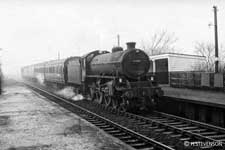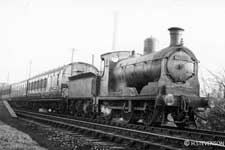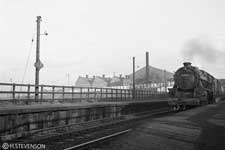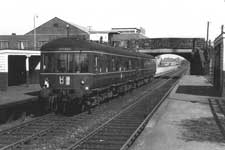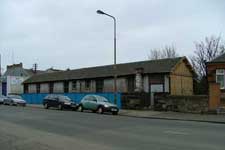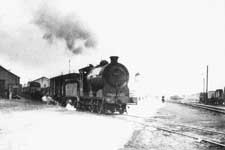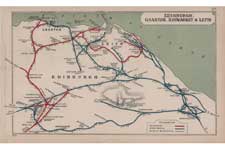Railways
On this page
The first railway to Granton Harbour
1842
The Edinburgh Leith & Newhaven Railway opened on 31 August 1842 between Scotland Street, in the New Town in Edinburgh, and Trinity Crescent, near the Chain Pier. The pier later blew down in a storm but at the time there were steamer services from it. Heavy engineering work was involved, and the line included a tunnel south of Trinity Station – one man lost his life in its construction. Initially the line ran straight to a terminal station, where flats entering off York Road now stand. The 5th Duke of Buccleuch![]() , who built Granton Harbour, was involved with the company.
, who built Granton Harbour, was involved with the company.
1846
The line was soon extended from Trinity over a bridge (Trinity Bridge) and along the shore to Granton Harbour, which had been opened in 1838. This involved a long embankment, gradually dropping down to pier level at Granton. At the city end the line went though a tunnel under Dublin Street and St Andrew Street to a station called Canal Street![]() , at right angles to the present Waverley Station. (There had been an 18th century project to form a canal in the valley between the Old and New Towns, which did not come to fruition.) A tightly curved connection (north to west) was formed with the Edinburgh & Glasgow Railway (recently extended from its original terminus at Haymarket), which itself met the North British Railway end-on. The station which these two companies shared went by various names over the years, initially being referred to as the General Station but eventually becoming Edinburgh Waverley. The end of the tunnel is marked by a notice on the wall at the recently built Platform 20. It was used for various purposes over the years, including growing mushrooms and as an air-raid shelter in World War II.
, at right angles to the present Waverley Station. (There had been an 18th century project to form a canal in the valley between the Old and New Towns, which did not come to fruition.) A tightly curved connection (north to west) was formed with the Edinburgh & Glasgow Railway (recently extended from its original terminus at Haymarket), which itself met the North British Railway end-on. The station which these two companies shared went by various names over the years, initially being referred to as the General Station but eventually becoming Edinburgh Waverley. The end of the tunnel is marked by a notice on the wall at the recently built Platform 20. It was used for various purposes over the years, including growing mushrooms and as an air-raid shelter in World War II.
The gradient in the tunnel from Canal Street to Scotland Street![]() was 1 in 27, too steep for steam locomotives, and trains were rope-hauled up it by a stationary engine at the top of the gradient. Trains heading north (down the gradient) were controlled by brake trucks. A similar method of operation was used between Glasgow Queen Street and Cowlairs until 1908. The section from Trinity to Granton opened on 19 February 1846 and Canal Street to Scotland Street on 17 May 1847. The company had been re-named the Edinburgh Leith & Granton Railway in 1844. A branch to North Leith, with a station on Commercial Street and a link across the road into Leith Docks, was also built and opened in 1846.
was 1 in 27, too steep for steam locomotives, and trains were rope-hauled up it by a stationary engine at the top of the gradient. Trains heading north (down the gradient) were controlled by brake trucks. A similar method of operation was used between Glasgow Queen Street and Cowlairs until 1908. The section from Trinity to Granton opened on 19 February 1846 and Canal Street to Scotland Street on 17 May 1847. The company had been re-named the Edinburgh Leith & Granton Railway in 1844. A branch to North Leith, with a station on Commercial Street and a link across the road into Leith Docks, was also built and opened in 1846.
At Granton, a passenger station was built on the curve of the railway from Lower Granton Road onto the Middle Pier. However, this seems to have lasted only for a few years, being replaced by a new station and revised track layout to suit the train ferries, which started public operation in February 1850. The new passenger station was further down the Middle Pier, with a shorter walking distance to the passenger ferry boats.
The train ferries (which conveyed goods wagons) and passenger ferry boats crossed the Firth of Forth from Granton to Burntisland. From 1850 to 1890 this was part of the main East Coast railway line to Perth, Dundee and Aberdeen. Most of the passengers who died in the Tay Bridge![]() disaster in December 1879 had travelled by this route a few hours previously, and directors of the North British Railway used the same route in the early hours of the morning to visit the site of the disaster.
disaster in December 1879 had travelled by this route a few hours previously, and directors of the North British Railway used the same route in the early hours of the morning to visit the site of the disaster.
1849
The Edinburgh Leith & Granton Railway amalgamated with the Edinburgh Perth & Dundee on 1 April 1849. The new company's services extended from Edinburgh to Tayport (for the ferry to Broughty Ferry and connections to Dundee and Aberdeen).
1862
A further amalgamation, on 29 July 1862, saw the line become part of a much larger company, the North British Railway.
1868
In 1868 the NBR opened a new line from Waverley Station through Abbeyhill to Bonnington, so that the steep tunnel could be closed and locomotives used for the whole journey. Trains then ran to and from the bay (terminal) platforms at the east end of Waverley.
1890
The opening of the Forth Bridge in 1890 resulted in the main line trains to the north ceasing to use the Granton – Burntisland route. The Granton branch was then used only for local passenger trains and goods traffic.
A railway accident occurred at Trinity Station on 1 November 1898 as the result of one of the two tracks being out of use following storm damage to the sea wall between there and Granton. The damage was caused by the same storms that destroyed the Chain Pier.
Click to see the April 1910 passenger train North British Railway Timetable.
1923
The North British Railway became part of the larger London & North Eastern Railway (LNER).
1925
The passenger trains stopped in 1925, a few years after the Edinburgh and Leith tramway systems were joined and passengers could travel into Edinburgh city centre without a change of tram. Until then the trains were made up of small steam engines with four-wheeled carriages but the journey from Granton to Edinburgh only took 13 minutes – less than the bus today.
1948
The LNER became part of the British Railways (BR).
1950s
The line on the approach to Granton Harbour was the location of a fatal accident on 24 April 1953 when a locomotive travelling at excessive speed struck another locomotive which was stationary.
Adobe Reader is needed to read the pdf document – if it is not installed on your computer, click the icon below for a free download.
1960s
Goods trains ran until 1986 following which the line was lifted and the embankment beside Lower Granton Road removed in 1991-1992. Part of the route, from Trinity to Canonmills, is now a walkway.
The Caledonian Railway
1861
The other main railway with lines in the Granton area was the Caledonian Railway. They opened a line to Granton from a line they already had at Dalry in 1861. This line was used for goods trains to Granton Harbour but there were no normal passenger trains. Later, when Granton Gas Works was built, there were special trains for workers at the Gas Works to get there. A junction was also formed, and rail connections made into the works.
1864
The Caledonian Railway built another new line in 1864, to Leith. The station (often called the ‘Caley Station’) was at the junction of Lindsay Road and Ocean Drive, at the foot of North Junction Street. The pub across the road was until 2009 still called the Caley Bar (it was until recently the Sports Bar). Passenger trains ran from there to Edinburgh Princes Street Station, beside the Caledonian Hotel (also generally called the ‘Caley Station’). This station replaced the previous Lothian Road Station in the 1890s.
1879
Passenger services from Edinburgh to Leith on this route started in 1879. In the Granton area there were stations at Newhaven Road (near Trinity Academy) and Granton Road
Click to see the April 1910 passenger train Caledonian Railway Timetable.
1923
The Caledonian Railway became part of the larger London Midland & Scottish Railway (LMS).
1934
A new station was added to the existing line – East Pilton (at first called East Pilton Halt). It was near to Bruce Peebles’ works.
1948
The LMS became part of the British Railways (BR).
I am very grateful to Mike Cooper and Hamish Stevenson for making the following four pictures of East Pilton from the late 1950s available to us.
1960s
Passenger trains ran until 1962, and goods trains until 1968. In the last few years, starting on 5 May 1958, the main service had been operated by diesel trains. This line is now a cycle path and walkway.
The Duke of Buccleuch
In addition to the lines owned by railway companies, the Duke of Buccleuch built and kept ownership until railway nationalisation in 1948 of lines at Granton Harbour. A charge was made to the owners of wagons using these lines, wagon numbers and details being recorded for the purpose. The Dukes are said to have had a worthwhile income from this, since in addition to vehicles accessing the Harbour the line was one of the few links in the Edinburgh area between the Caledonian (later LMS) and North British (later LNER) systems. Goods traffic was therefore regularly transferred between systems at Granton.
Granton Gas Works
Granton Gas Works also had its own railway lines, both standard gauge – connecting to the Caledonian Railway – and narrow gauge – for internal use.
Railway maps



Diagrams showing the development of the railways: 1842, 1846, 1847, 1861, 1864 and 1868
Click the images to enlarge



